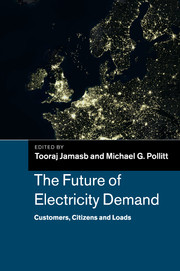Book contents
- Frontmatter
- Contents
- List of Figures
- List of Tables
- List of Boxes
- List of Contributors
- Foreword
- Preface
- Acknowledgements
- Introduction and overview of the chapters
- Part I The economics
- Part II Technology
- 5 Demand-side management and control in buildings
- 6 Smart metering: technology, economics and international experience
- 7 Smart domestic appliances as enabling technology for demand-side integration: modelling, value and drivers
- 8 The scope for and potential impacts of the adoption of electric vehicles in UK surface transport
- Part III Social dimensions
- Part IV Policy and regulation
- Index
- References
5 - Demand-side management and control in buildings
from Part II - Technology
Published online by Cambridge University Press: 05 March 2014
- Frontmatter
- Contents
- List of Figures
- List of Tables
- List of Boxes
- List of Contributors
- Foreword
- Preface
- Acknowledgements
- Introduction and overview of the chapters
- Part I The economics
- Part II Technology
- 5 Demand-side management and control in buildings
- 6 Smart metering: technology, economics and international experience
- 7 Smart domestic appliances as enabling technology for demand-side integration: modelling, value and drivers
- 8 The scope for and potential impacts of the adoption of electric vehicles in UK surface transport
- Part III Social dimensions
- Part IV Policy and regulation
- Index
- References
Summary
Introduction
In order to decarbonize the energy-supply system, policies have been introduced to stimulate an increase in the amount of energy we use from clean and renewable energy systems. With the progressive increase in the quantities of clean and renewable energy-supply systems being commissioned, there comes a point where due to the intermittency and unpredictability of renewables it is difficult to maintain a demand–supply balance. In such circumstances, the traditional control theories of energy supply being demand following cannot be enacted. In order to maintain the integrity of the demand–supply match, the onus of control needs to shift from the supply side to the demand side. Ideally, we would like to have flexibility and infinite control over each load so that control can be enacted which enables the energy demand to become supply following. The control being enacted on each load type would be such that the functionality or comfort levels each individual load is satisfying would not be compromised. Thus, this level of discrete control would result in the building occupant/user being unaware of control measures being enacted. In practice, however, this may not be feasible. Therefore the purpose of this chapter is to explore how we may achieve increased levels of control over individual loads, the impact this will have on introducing flexibility into the demand side, and how this could be implemented at a practical level.
Drivers for DSM and control within buildings
A number of drivers exist to influence and accelerate the penetration of demand-side management (DSM) within the built environment, specifically within the domestic sector. These drivers include evolving energy policy, improved energy efficiency through the use of more efficient appliances, the increased uptake and technological advancements in the microgeneration system, and the development and application of information and communication technologies to control and optimize the energy supply–demand match, while being sympathetic to the building environmental conditions being attained.
- Type
- Chapter
- Information
- The Future of Electricity DemandCustomers, Citizens and Loads, pp. 129 - 160Publisher: Cambridge University PressPrint publication year: 2011

